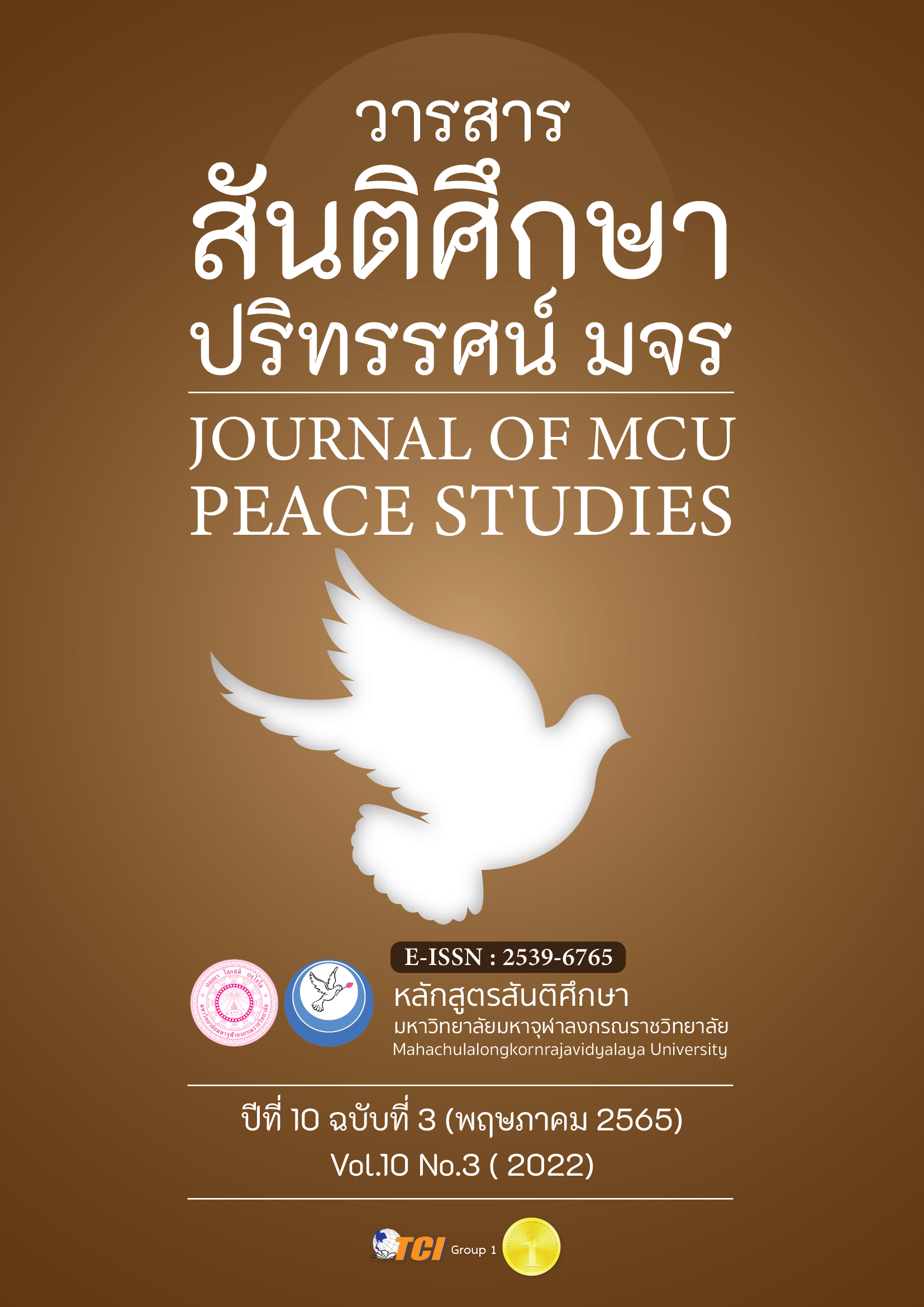The Influence of Customer Experience in Thai Full-Service Restaurant towards Customer Satisfaction with Consumption Emotion as Mediator: International Tourists’ Perspective
Main Article Content
บทคัดย่อ
This research aimed to study (1) the influence of customer experience in Thai full-service restaurants toward customer satisfaction (2) to investigate the mediating effect of customer emotion between customer experience and customer satisfaction. The sample size was 400 international tourists who visited Thai full-service restaurants, the respondents were selected by purposive sampling. The sample group was selected from international tourist who visited Thai full-service restaurant according to the provided list. Analysis the data by the descriptive statistic and the Structural Equation Model use to analyze the causal relationship between customer and experience and have consumption emotion as the mediating factor.
The research result was found as follows. 1. The result indicated that customer experience insignificantly influenced on customer satisfaction. 2. The customer experience indirectly influenced customer satisfaction by passing through the consumption emotion as the mediating factor. 3. Thai full-service restaurant operators should pay attention to the design of experience touchpoints that influence the consumption emotion to construct customer satisfaction, leading to competitive advantage and creating sustainable operation in the highly competitive restaurant business.
Article Details

อนุญาตภายใต้เงื่อนไข Creative Commons Attribution-NonCommercial-NoDerivatives 4.0 International License.
ทัศนะและความคิดเห็นที่ปรากฏในบทความในวารสาร ถือเป็นความรับผิดชอบของผู้เขียนบทความนั้น และไม่ถือเป็นทัศนะและความรับผิดชอบของกองบรรณาธิการ ยินยอมว่าบทความเป็นลิขสิทธิ์ของวารสาร
เอกสารอ้างอิง
Andaleeb, S. S., & Conway, C. (2006). Customer Satisfaction in the Restaurant Industry: An Examination of the Transaction-Specific Model. Journal of Services Marketing.
Andersson, T. D., & Mossberg, L. (2004). The Dining Experience: Do Restaurants Satisfy Customer Needs? Food Service Technology, 4(4), 171-177.
Babolian Hendijani, R., Sambasivan, M., Ng, S., & Boo, H. (2013). Effect of Gastronomy Experience on Overall Satisfaction: Differences between Backpackers and Mass Tourists in Malaysia. Reading on Hospitality and Tourism Issues, 107-123.
Berry, L. L., & Carbone, L. P. (2007). Build Loyalty Through Experience Management. Quality Progress, 40(9), 26.
Björk, P., & Kauppinen-Räisänen, H. (2016). Local Food: A Source for Destination Attraction. International Journal of Contemporary Hospitality Management.
Carù, A., & Cova, B. (2003). Revisiting Consumption Experience: A More Humble but Complete View of the Concept. Marketing Theory, 3(2), 267-286.
Churchill Jr., G. A., & Surprenant, C. (1982). An Investigation into the Determinants of Customer Satisfaction. Journal of Marketing Research, 19(4), 491-504.
Cohen, E., & Avieli, N. (2004). Food in Tourism: Attraction and Impediment. Annals of Tourism Research, 31(4), 755-778.
Ministry of Tourism and Sport, Department of Tourism (2016). Database. Bangkok: Department of Tourism. Retrieved from http://www.tourism.go.th/home/details/11/221/24710
Garg, R., Rahman, Z., & Kumar, I. (2011). Customer Experience: A Critical Literature Review and Research Agenda. International Journal of Services Sciences, 4(2), 146-173.
Grønholdt, L., Martensen, A., Jørgensen, S., & Jensen, P. (2015). Customer Experience Management and Business Performance. International Journal of Quality and Service Sciences, 7(1), 90-106.
Hair, J. F., Black, W. C., Babin, B. J., & Anderson, R. E. (2010). Multivariate Data Analysis: International Version. New Jersey: Pearson.
Hall, C. M., Sharples, L., Mitchell, R., Macionis, N., & Cambourne, B. (2004). Food Tourism around the World: Routledge.
Han, H., Back, K.-J., & Barrett, B. (2010). A Consumption Emotion Measurement Development: A Full-Service Restaurant Setting. The Service Industries Journal, 30(2), 299-320.
Henderson, J. C. (2009). Food Tourism Reviewed. British Food Journal, 111(4), 317-326.
Kivela, J., & Crotts, J. C. (2006). Tourism and Gastronomy: Gastronomy's Influence on How Tourists Experience a Destination. Journal of Hospitality & Tourism Research, 30(3), 354-377.
Kline, R. B. (2011). Convergence of Structural Equation Modeling and Multilevel Modeling. n.p.
Kotler, P., Kartajaya, H., & Setiawan, I. (2010). Marketing 3.0: From Products to Customers to the Human Spirit: John Wiley & Sons.
Lee, K.-H., Scott, N., & Packer, J. (2014). Where Does Food Fit in Tourism? Tourism Recreation Research, 39(2), 269-274.
Mak, A. H., Lumbers, M., Eves, A., & Chang, R. C. (2012). Factors Influencing Tourist Food Consumption. International Journal of Hospitality Management, 31(3), 928-936.
Meyer, C., & Schwager, A. (2007b). Understanding Customer Experience. Harvard Business Review, 85(2), 116.
Nemeschansky, B., & Von der Heidt, T. (2013). The Future of Restaurant Analysis: A Customer-Driven Approach for an Experience Economy.
Prahalad, C. K., & Ramaswamy, V. (2004). Co-Creation Experiences: The Next Practice in Value Creation. Journal of Interactive Marketing, 18(3), 5-14.
Ryu, K., & Han, H. (2010). Influence of Physical Environment on Disconfirmation, Customer Satisfaction, and Customer Loyalty for First-Time and Repeat Customers in Upscale Restaurants.
Schmitt, B. H. (2010). Customer Experience Management: A Revolutionary Approach to Connecting with your Customers: John Wiley & Sons.
Sharma, G. (2017). Pros and Cons of Different Sampling Techniques. International Journal of Applied Research, 3(7), 749-752.
Shaw, C., & Ivens, J. (2005). Building Great Customer Experiences. New York: MacMillan.
Sparks, B. A., Wildman, K. L., & Bowen, J. T. (2001). Restaurants as a Contributor to Tourist Destination Attractiveness. Australian Journal of Hospitality Management, 8(2), 17-30.
Sparks, B., Bowen, J., & Klag, S. (2003). Restaurants and the Tourist Market. International Journal of Contemporary Hospitality Management, 15(1), 6-13.
Turner, R. C., & Carlson, L. (2003). Indexes of Item-Objective Congruence for Multidimensional Items. International Journal of Testing, 3(2), 163-171.
Verhoef, P. C., Lemon, K. N., Parasuraman, A., Roggeveen, A., Tsiros, M., & Schlesinger, L. A. (2009). Customer Experience Creation: Determinants, Dynamics and Management Strategies. Journal of Retailing, 85(1), 31-41.
Walls, A. R., Okumus, F., Wang, Y. R., & Kwun, D. J.-W. (2011). An Epistemological View of Consumer Experiences. International Journal of Hospitality Management, 30(1), 10-21.
Wilson, A., Zeithaml, V. A., Bitner, M. J., & Gremler, D. D. (2012). Services Marketing: Integrating Customer Focus Across the Firm: McGraw Hill.
Yuan, Y.-H. E., & Wu, C. K. (2008). Relationships among Experiential Marketing, Experiential Value, and Customer Satisfaction. Journal of Hospitality & Tourism Research, 32(3), 387-410.


